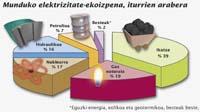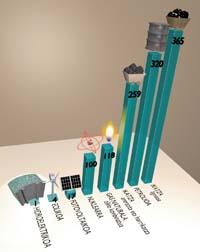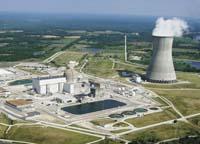Ranking of contamination by electric sources

The availability and prosperity of the current energy allows many people to enjoy comfort and mobility in an unprecedented measure. But for this, man spends an average of energy 100 times more than before using fire. And we must take into account the pollution and environmental impact that this energy consumption entails.
A third of the total energy production is destined to the generation of electricity. The rest is mainly intended for transport and heating. Electricity generation requires the exploitation of various energy sources, such as coal, oil, natural gas or uranium. In fact, electricity is an efficient and clean energy for consumption, but it generates environmental impacts in its generation phase.
In any case, it is not possible to put all the energy sources at the same level, at least as regards pollution. Not generalizable. All technologies that produce electricity pollute more or less. Therefore, by consuming electricity, in any case, we are polluting the environment. That is inevitably so. But, starting to compare, there are differences between each other. The recent research carried out by the Catalan environmental and energy consultant, AUMA, highlights the great differences between the environmental impacts of electricity sources.
The results show that the technologies that use fossil fuels are the ones that have the greatest environmental impact. Of these, coal and oil are the main pollutants, with lignite plants being the most polluting. The plants with lower environmental impact are hydroelectric and wind farms.
Exploitation of the most polluting sources

After the results, flashy data appear. In fact, energy sources with the greatest environmental impact are the most exploited. Coal is, by far, the most used fuel in the world to generate electricity. As for the electrical system of the Spanish state, coal and natural gas are the most exploited, generating between them half of the total electricity of the state and closely following the nuclear.
Those responsible for this are fundamentally economic. The exploitation of fossil fuels and nuclear energy has always been very economical technologically compared to renewable energies. In addition, thermal power plants have an almost total utility throughout the year and produce much more than renewables. In fact, the production of renewables largely depends on time -- sun, wind and flow are not always guaranteed. Since the electricity market pays each producer based on the kWh or generated energy units, the most polluting production technologies have offered great business opportunities. But things are changing little by little.
We must take into account the economic incentives that renewable producers receive from governments. In addition, the development of renewable energy technology increases its efficiency over the years. Thus, each unit of energy generated by wind power plants or photovoltaic panels is increasingly economical. In addition, the environmental impact of these technologies has decreased considerably in recent years.
The most significant example is that of photovoltaic cells. If the ACV 1999 and 2008 studies of the company AUMA are compared, the environmental impact score of the photovoltaic facilities has been reduced almost 5 times. The key to this change lies in the materials of the photovoltaic panels, which in the last ten years have improved notably in quality and contagiousness. And the photovoltaic industry is constantly reducing its costs. For all this, renewable energy facilities have increased considerably in recent years thanks to energy demand and business opportunities.

Economic effects of damage: external costs
Beyond the economic costs of some and other technologies, we must also take into account the environmental and social costs associated with each energy source. These costs, known as “external costs”, analyze the economic implications of each manufacturer of electricity for human health, ecosystems, crops, buildings and the greenhouse effect, among others. We take into account, for example, the considerable losses that occurred in the case of the Prestige or the expenses that imply for public health the emissions of polluting gases.
The External Report of the European Commission has estimated the monetary value of external costs. This means that if these costs were expressed in the bill of light, electricity from coal and oil would have to be added an average of 5 cents per kWh. On the contrary, the external cost of electricity generated by hydroelectric power plants is 0.4 cents, while the cost of wind power is only 0.15 cents. These values vary from country to country, but the difference between fossil fuels and renewable energies is evident. According to the authors of the report, these data should be taken into account in political actions, for example, by taxes or ecorates to the most harmful fuels and technologies, or by incentives to producers of electricity with lower socio-ecological cost. The subject, however, has many vertices and is about to see the measures to be taken.
Challenges of the future

The demand for energy continues to grow year after year and the electric system has each and every energy source needed to respond to this demand: this argument is gaining strength in recent times. In addition, despite the disadvantages, many experts believe that in the future it will have to be reinforced, especially arguing that the vacuum that will leave the oil crisis will have to be filled in some way.
Oil and natural gas reserves only offer for decades. With the current production level and fuel deposits known so far, oil reserves are only guaranteed for about 40 years and natural gas is only available for 60 years. Coal will run out in less than three centuries. In addition, reserves are not the only problem of the energy sector, but the exponential growth of world consumption.
It will not be possible, therefore, to supply more with less: the rope will be cut on either side. In the society of the future, the model of civilization and consumption habits must be necessarily modified to achieve true energy viability.

But that doesn't have to be a disaster: there are significant examples around the world. In Japan, for example, very few people use the particular car to move, and in that society it is unthinkable that each person owns a car. In London, traffic was solved when they started charging to access the city centre and in Denmark the taxes go up a lot. They are decisions contrary to the majority will, but without great margins of manoeuvre.
We will have to see what measures will be taken in the near future and how society will respond to these measures. And the key will be how all this is managed.





Buletina
Bidali zure helbide elektronikoa eta jaso asteroko buletina zure sarrera-ontzian











